Auditing Origin Energy: Materiality, Audit Procedures, and Review
VerifiedAdded on 2022/12/18
|10
|2096
|54
Report
AI Summary
This report provides a comprehensive analysis of the 2018 audit of Origin Energy. Section 1 focuses on determining the level of materiality, discussing relevant benchmarks such as total assets due to the company's operating loss and recent small profit, and applying a 5% threshold. It also identifies significant audit areas, including contingent liabilities (guarantees, joint arrangements, and capital expenditures) and a change in accounting method. Section 2 conducts a preliminary analytical review using profitability, liquidity, and leverage ratios. The review highlights key financial trends, such as the company's operating profit, fluctuations in current and quick ratios, and changes in debt levels, and discusses the implications for the audit, including potential risks of misstatement and related audit procedures to verify financial statement assertions. The report emphasizes the importance of these aspects for a thorough audit of Origin Energy's financial statements.
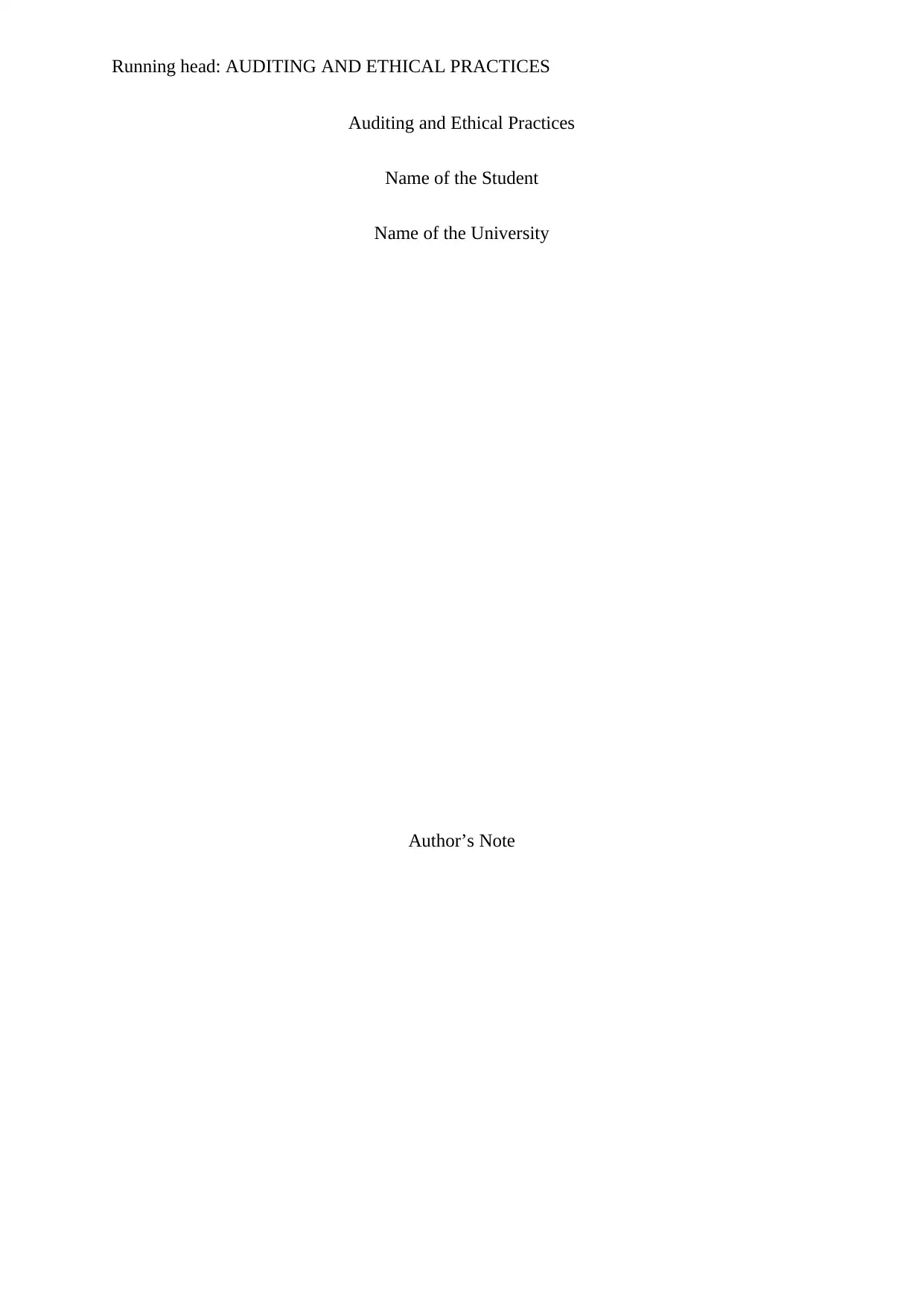
Running head: AUDITING AND ETHICAL PRACTICES
Auditing and Ethical Practices
Name of the Student
Name of the University
Author’s Note
Auditing and Ethical Practices
Name of the Student
Name of the University
Author’s Note
Paraphrase This Document
Need a fresh take? Get an instant paraphrase of this document with our AI Paraphraser
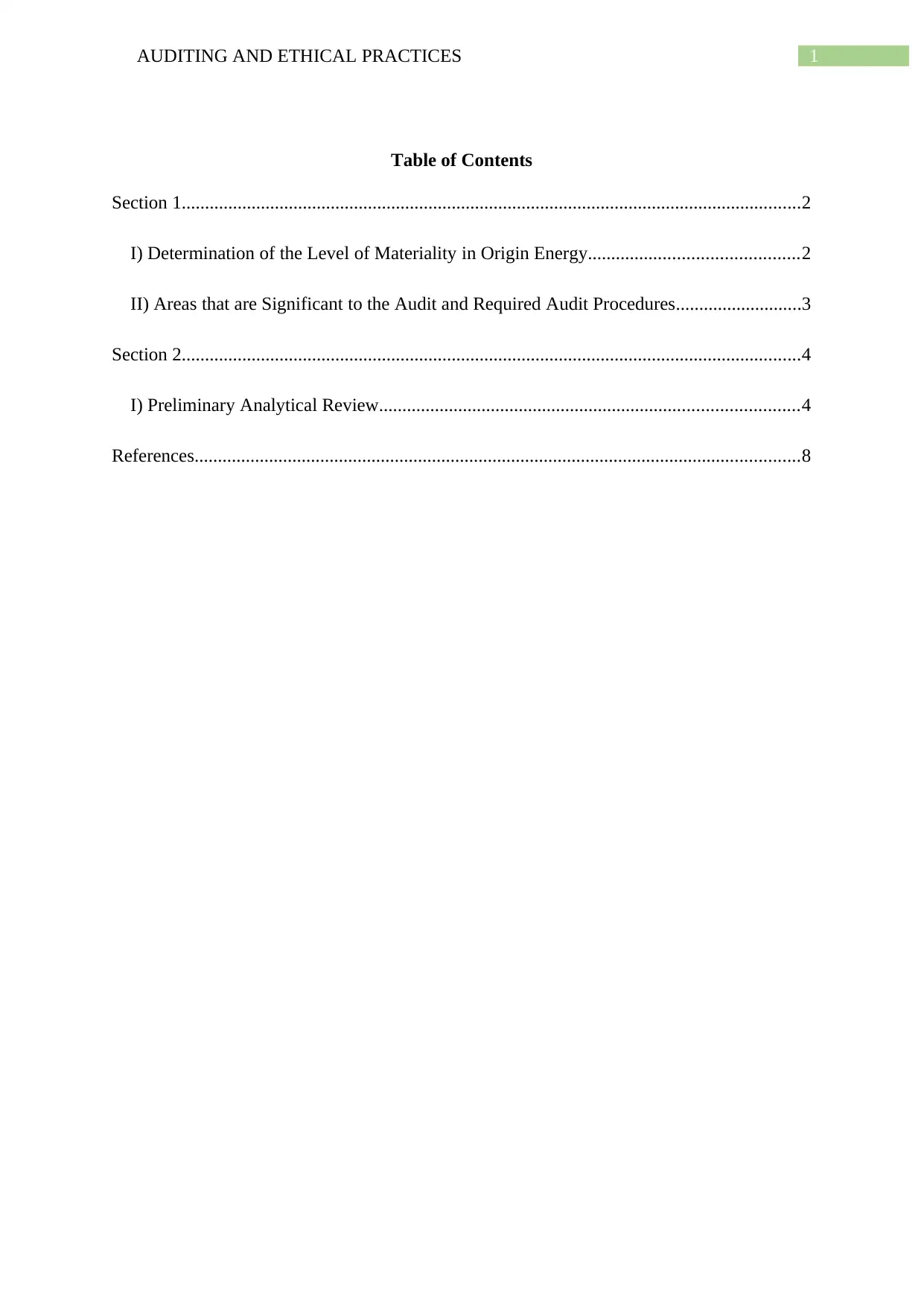
1AUDITING AND ETHICAL PRACTICES
Table of Contents
Section 1.....................................................................................................................................2
I) Determination of the Level of Materiality in Origin Energy.............................................2
II) Areas that are Significant to the Audit and Required Audit Procedures...........................3
Section 2.....................................................................................................................................4
I) Preliminary Analytical Review..........................................................................................4
References..................................................................................................................................8
Table of Contents
Section 1.....................................................................................................................................2
I) Determination of the Level of Materiality in Origin Energy.............................................2
II) Areas that are Significant to the Audit and Required Audit Procedures...........................3
Section 2.....................................................................................................................................4
I) Preliminary Analytical Review..........................................................................................4
References..................................................................................................................................8
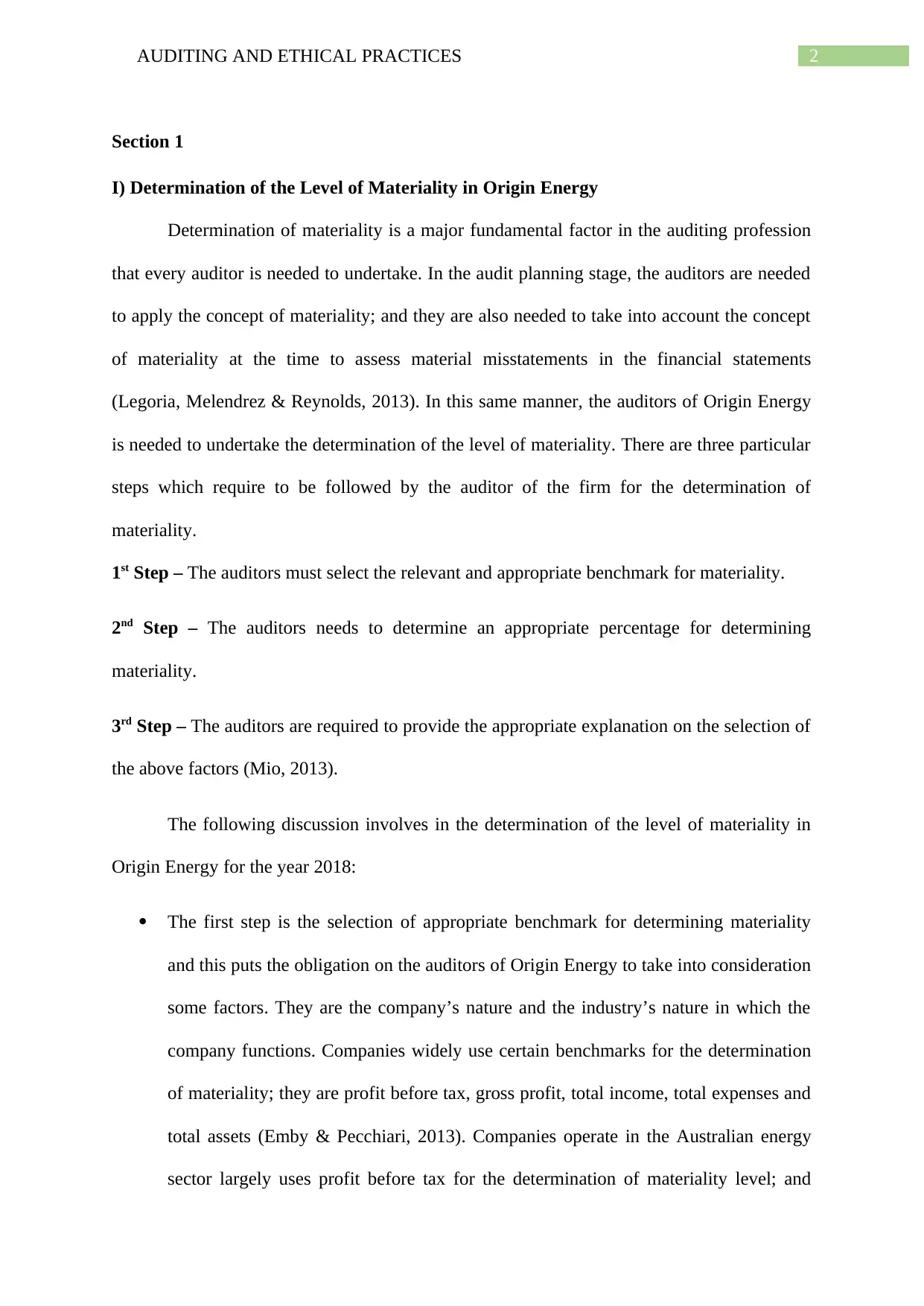
2AUDITING AND ETHICAL PRACTICES
Section 1
I) Determination of the Level of Materiality in Origin Energy
Determination of materiality is a major fundamental factor in the auditing profession
that every auditor is needed to undertake. In the audit planning stage, the auditors are needed
to apply the concept of materiality; and they are also needed to take into account the concept
of materiality at the time to assess material misstatements in the financial statements
(Legoria, Melendrez & Reynolds, 2013). In this same manner, the auditors of Origin Energy
is needed to undertake the determination of the level of materiality. There are three particular
steps which require to be followed by the auditor of the firm for the determination of
materiality.
1st Step – The auditors must select the relevant and appropriate benchmark for materiality.
2nd Step – The auditors needs to determine an appropriate percentage for determining
materiality.
3rd Step – The auditors are required to provide the appropriate explanation on the selection of
the above factors (Mio, 2013).
The following discussion involves in the determination of the level of materiality in
Origin Energy for the year 2018:
The first step is the selection of appropriate benchmark for determining materiality
and this puts the obligation on the auditors of Origin Energy to take into consideration
some factors. They are the company’s nature and the industry’s nature in which the
company functions. Companies widely use certain benchmarks for the determination
of materiality; they are profit before tax, gross profit, total income, total expenses and
total assets (Emby & Pecchiari, 2013). Companies operate in the Australian energy
sector largely uses profit before tax for the determination of materiality level; and
Section 1
I) Determination of the Level of Materiality in Origin Energy
Determination of materiality is a major fundamental factor in the auditing profession
that every auditor is needed to undertake. In the audit planning stage, the auditors are needed
to apply the concept of materiality; and they are also needed to take into account the concept
of materiality at the time to assess material misstatements in the financial statements
(Legoria, Melendrez & Reynolds, 2013). In this same manner, the auditors of Origin Energy
is needed to undertake the determination of the level of materiality. There are three particular
steps which require to be followed by the auditor of the firm for the determination of
materiality.
1st Step – The auditors must select the relevant and appropriate benchmark for materiality.
2nd Step – The auditors needs to determine an appropriate percentage for determining
materiality.
3rd Step – The auditors are required to provide the appropriate explanation on the selection of
the above factors (Mio, 2013).
The following discussion involves in the determination of the level of materiality in
Origin Energy for the year 2018:
The first step is the selection of appropriate benchmark for determining materiality
and this puts the obligation on the auditors of Origin Energy to take into consideration
some factors. They are the company’s nature and the industry’s nature in which the
company functions. Companies widely use certain benchmarks for the determination
of materiality; they are profit before tax, gross profit, total income, total expenses and
total assets (Emby & Pecchiari, 2013). Companies operate in the Australian energy
sector largely uses profit before tax for the determination of materiality level; and
⊘ This is a preview!⊘
Do you want full access?
Subscribe today to unlock all pages.

Trusted by 1+ million students worldwide
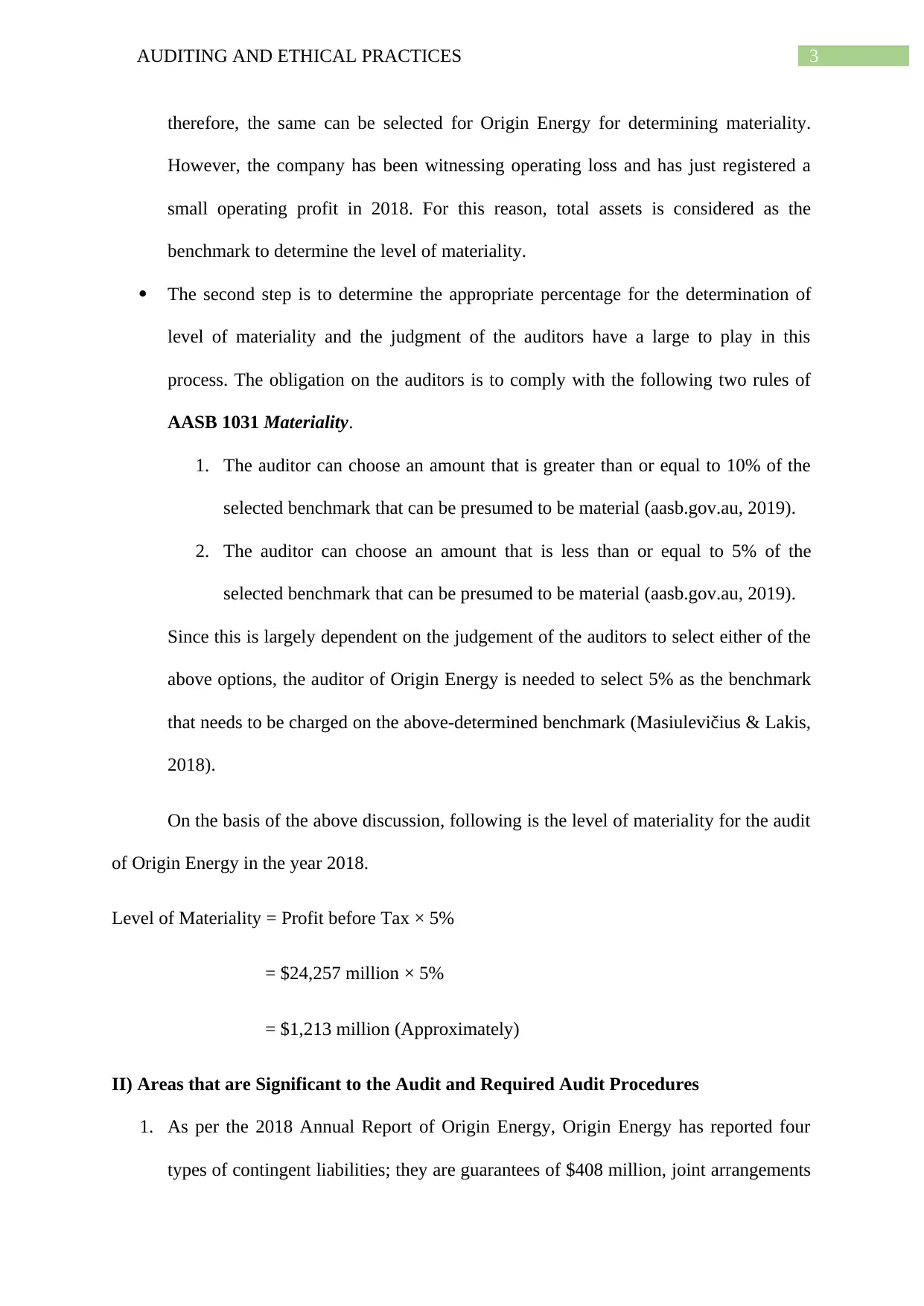
3AUDITING AND ETHICAL PRACTICES
therefore, the same can be selected for Origin Energy for determining materiality.
However, the company has been witnessing operating loss and has just registered a
small operating profit in 2018. For this reason, total assets is considered as the
benchmark to determine the level of materiality.
The second step is to determine the appropriate percentage for the determination of
level of materiality and the judgment of the auditors have a large to play in this
process. The obligation on the auditors is to comply with the following two rules of
AASB 1031 Materiality.
1. The auditor can choose an amount that is greater than or equal to 10% of the
selected benchmark that can be presumed to be material (aasb.gov.au, 2019).
2. The auditor can choose an amount that is less than or equal to 5% of the
selected benchmark that can be presumed to be material (aasb.gov.au, 2019).
Since this is largely dependent on the judgement of the auditors to select either of the
above options, the auditor of Origin Energy is needed to select 5% as the benchmark
that needs to be charged on the above-determined benchmark (Masiulevičius & Lakis,
2018).
On the basis of the above discussion, following is the level of materiality for the audit
of Origin Energy in the year 2018.
Level of Materiality = Profit before Tax × 5%
= $24,257 million × 5%
= $1,213 million (Approximately)
II) Areas that are Significant to the Audit and Required Audit Procedures
1. As per the 2018 Annual Report of Origin Energy, Origin Energy has reported four
types of contingent liabilities; they are guarantees of $408 million, joint arrangements
therefore, the same can be selected for Origin Energy for determining materiality.
However, the company has been witnessing operating loss and has just registered a
small operating profit in 2018. For this reason, total assets is considered as the
benchmark to determine the level of materiality.
The second step is to determine the appropriate percentage for the determination of
level of materiality and the judgment of the auditors have a large to play in this
process. The obligation on the auditors is to comply with the following two rules of
AASB 1031 Materiality.
1. The auditor can choose an amount that is greater than or equal to 10% of the
selected benchmark that can be presumed to be material (aasb.gov.au, 2019).
2. The auditor can choose an amount that is less than or equal to 5% of the
selected benchmark that can be presumed to be material (aasb.gov.au, 2019).
Since this is largely dependent on the judgement of the auditors to select either of the
above options, the auditor of Origin Energy is needed to select 5% as the benchmark
that needs to be charged on the above-determined benchmark (Masiulevičius & Lakis,
2018).
On the basis of the above discussion, following is the level of materiality for the audit
of Origin Energy in the year 2018.
Level of Materiality = Profit before Tax × 5%
= $24,257 million × 5%
= $1,213 million (Approximately)
II) Areas that are Significant to the Audit and Required Audit Procedures
1. As per the 2018 Annual Report of Origin Energy, Origin Energy has reported four
types of contingent liabilities; they are guarantees of $408 million, joint arrangements
Paraphrase This Document
Need a fresh take? Get an instant paraphrase of this document with our AI Paraphraser
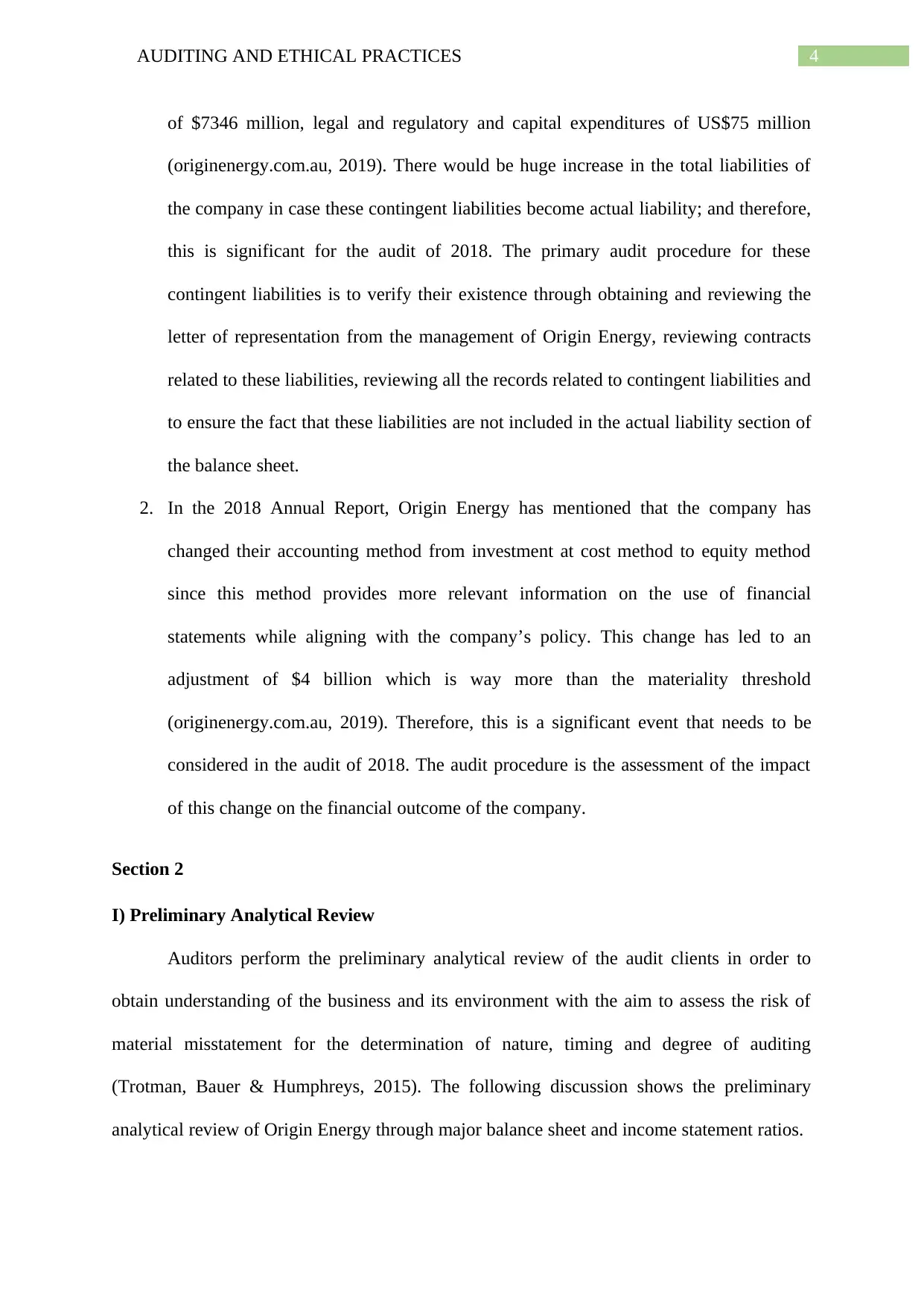
4AUDITING AND ETHICAL PRACTICES
of $7346 million, legal and regulatory and capital expenditures of US$75 million
(originenergy.com.au, 2019). There would be huge increase in the total liabilities of
the company in case these contingent liabilities become actual liability; and therefore,
this is significant for the audit of 2018. The primary audit procedure for these
contingent liabilities is to verify their existence through obtaining and reviewing the
letter of representation from the management of Origin Energy, reviewing contracts
related to these liabilities, reviewing all the records related to contingent liabilities and
to ensure the fact that these liabilities are not included in the actual liability section of
the balance sheet.
2. In the 2018 Annual Report, Origin Energy has mentioned that the company has
changed their accounting method from investment at cost method to equity method
since this method provides more relevant information on the use of financial
statements while aligning with the company’s policy. This change has led to an
adjustment of $4 billion which is way more than the materiality threshold
(originenergy.com.au, 2019). Therefore, this is a significant event that needs to be
considered in the audit of 2018. The audit procedure is the assessment of the impact
of this change on the financial outcome of the company.
Section 2
I) Preliminary Analytical Review
Auditors perform the preliminary analytical review of the audit clients in order to
obtain understanding of the business and its environment with the aim to assess the risk of
material misstatement for the determination of nature, timing and degree of auditing
(Trotman, Bauer & Humphreys, 2015). The following discussion shows the preliminary
analytical review of Origin Energy through major balance sheet and income statement ratios.
of $7346 million, legal and regulatory and capital expenditures of US$75 million
(originenergy.com.au, 2019). There would be huge increase in the total liabilities of
the company in case these contingent liabilities become actual liability; and therefore,
this is significant for the audit of 2018. The primary audit procedure for these
contingent liabilities is to verify their existence through obtaining and reviewing the
letter of representation from the management of Origin Energy, reviewing contracts
related to these liabilities, reviewing all the records related to contingent liabilities and
to ensure the fact that these liabilities are not included in the actual liability section of
the balance sheet.
2. In the 2018 Annual Report, Origin Energy has mentioned that the company has
changed their accounting method from investment at cost method to equity method
since this method provides more relevant information on the use of financial
statements while aligning with the company’s policy. This change has led to an
adjustment of $4 billion which is way more than the materiality threshold
(originenergy.com.au, 2019). Therefore, this is a significant event that needs to be
considered in the audit of 2018. The audit procedure is the assessment of the impact
of this change on the financial outcome of the company.
Section 2
I) Preliminary Analytical Review
Auditors perform the preliminary analytical review of the audit clients in order to
obtain understanding of the business and its environment with the aim to assess the risk of
material misstatement for the determination of nature, timing and degree of auditing
(Trotman, Bauer & Humphreys, 2015). The following discussion shows the preliminary
analytical review of Origin Energy through major balance sheet and income statement ratios.
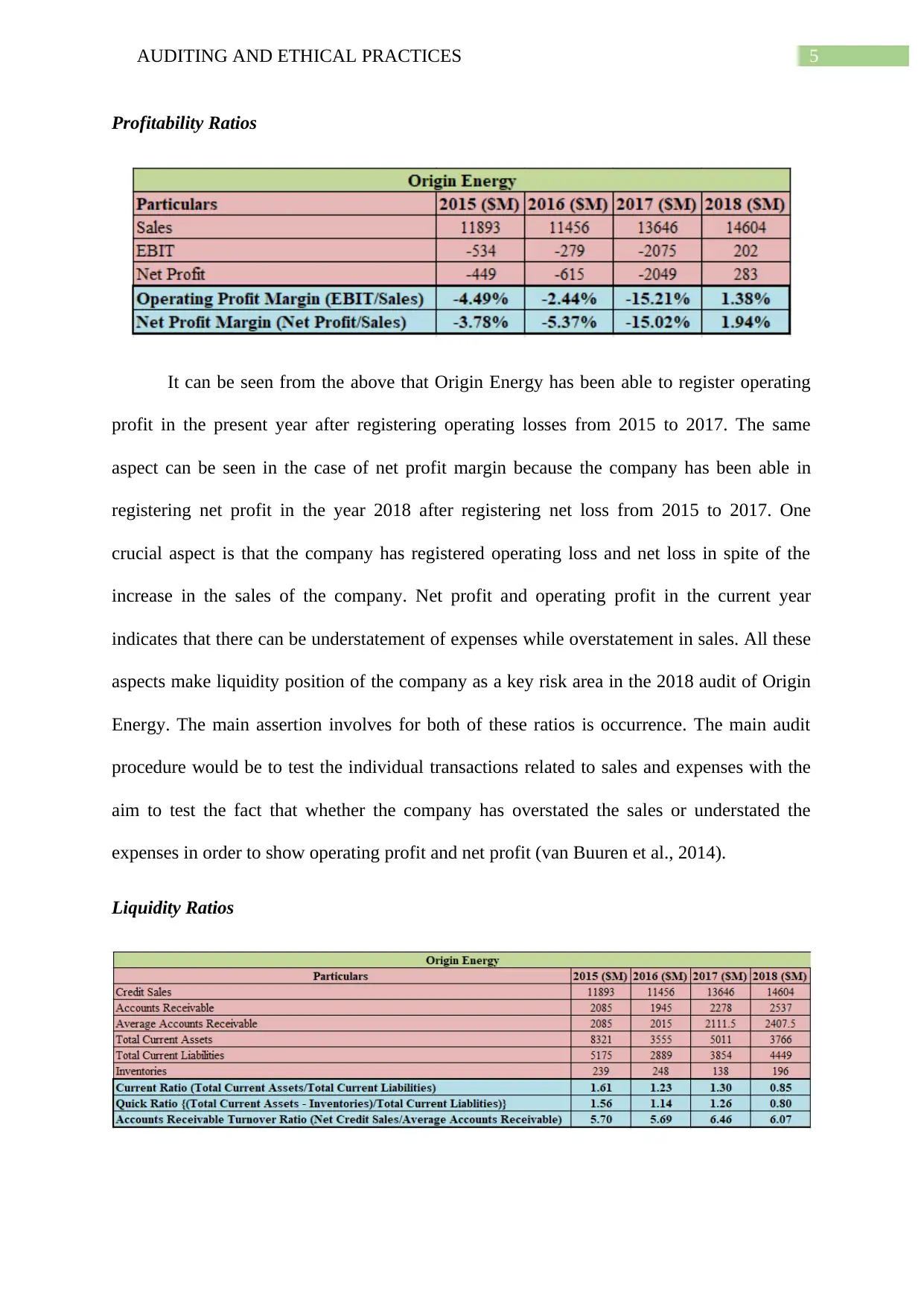
5AUDITING AND ETHICAL PRACTICES
Profitability Ratios
It can be seen from the above that Origin Energy has been able to register operating
profit in the present year after registering operating losses from 2015 to 2017. The same
aspect can be seen in the case of net profit margin because the company has been able in
registering net profit in the year 2018 after registering net loss from 2015 to 2017. One
crucial aspect is that the company has registered operating loss and net loss in spite of the
increase in the sales of the company. Net profit and operating profit in the current year
indicates that there can be understatement of expenses while overstatement in sales. All these
aspects make liquidity position of the company as a key risk area in the 2018 audit of Origin
Energy. The main assertion involves for both of these ratios is occurrence. The main audit
procedure would be to test the individual transactions related to sales and expenses with the
aim to test the fact that whether the company has overstated the sales or understated the
expenses in order to show operating profit and net profit (van Buuren et al., 2014).
Liquidity Ratios
Profitability Ratios
It can be seen from the above that Origin Energy has been able to register operating
profit in the present year after registering operating losses from 2015 to 2017. The same
aspect can be seen in the case of net profit margin because the company has been able in
registering net profit in the year 2018 after registering net loss from 2015 to 2017. One
crucial aspect is that the company has registered operating loss and net loss in spite of the
increase in the sales of the company. Net profit and operating profit in the current year
indicates that there can be understatement of expenses while overstatement in sales. All these
aspects make liquidity position of the company as a key risk area in the 2018 audit of Origin
Energy. The main assertion involves for both of these ratios is occurrence. The main audit
procedure would be to test the individual transactions related to sales and expenses with the
aim to test the fact that whether the company has overstated the sales or understated the
expenses in order to show operating profit and net profit (van Buuren et al., 2014).
Liquidity Ratios
⊘ This is a preview!⊘
Do you want full access?
Subscribe today to unlock all pages.

Trusted by 1+ million students worldwide
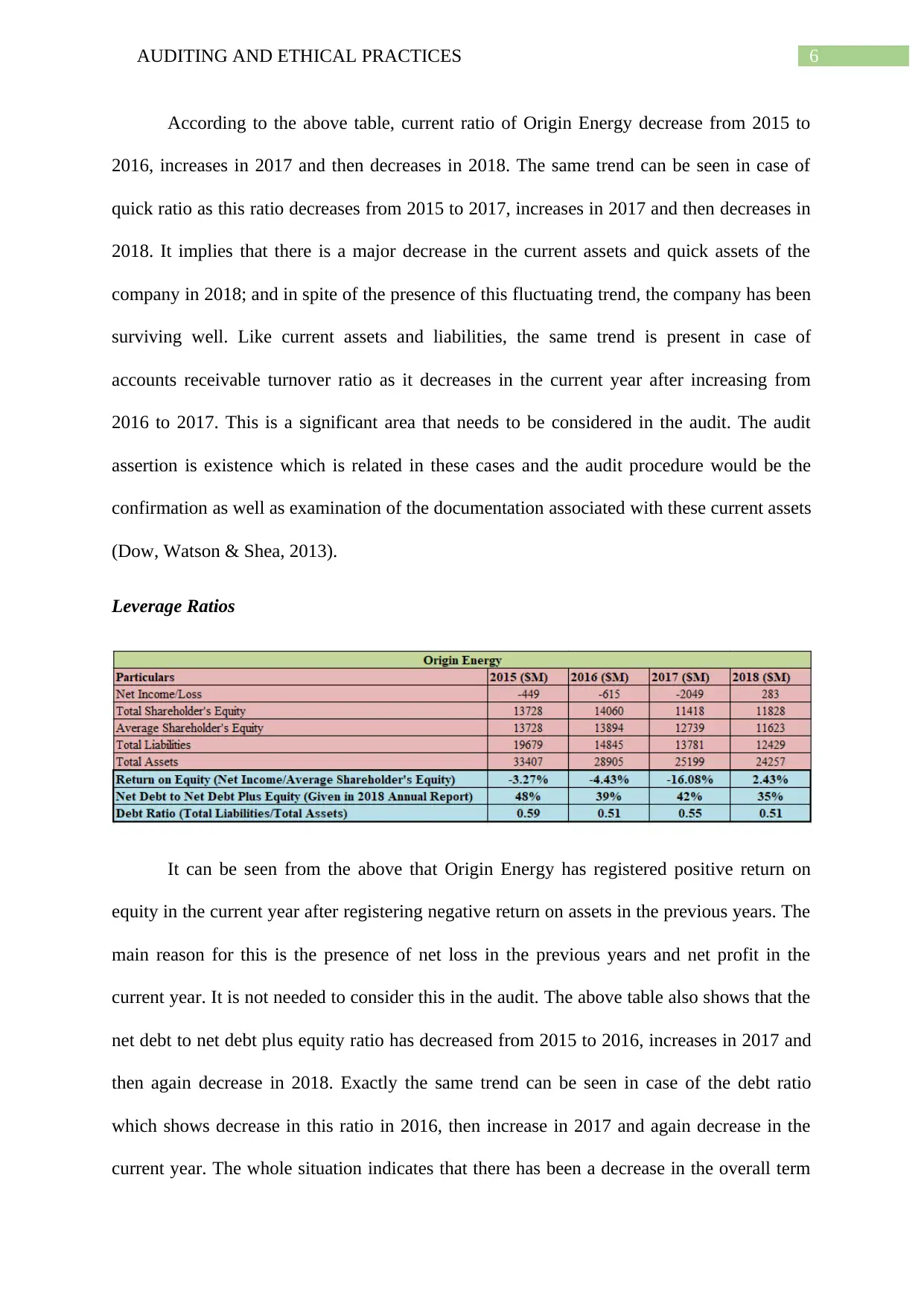
6AUDITING AND ETHICAL PRACTICES
According to the above table, current ratio of Origin Energy decrease from 2015 to
2016, increases in 2017 and then decreases in 2018. The same trend can be seen in case of
quick ratio as this ratio decreases from 2015 to 2017, increases in 2017 and then decreases in
2018. It implies that there is a major decrease in the current assets and quick assets of the
company in 2018; and in spite of the presence of this fluctuating trend, the company has been
surviving well. Like current assets and liabilities, the same trend is present in case of
accounts receivable turnover ratio as it decreases in the current year after increasing from
2016 to 2017. This is a significant area that needs to be considered in the audit. The audit
assertion is existence which is related in these cases and the audit procedure would be the
confirmation as well as examination of the documentation associated with these current assets
(Dow, Watson & Shea, 2013).
Leverage Ratios
It can be seen from the above that Origin Energy has registered positive return on
equity in the current year after registering negative return on assets in the previous years. The
main reason for this is the presence of net loss in the previous years and net profit in the
current year. It is not needed to consider this in the audit. The above table also shows that the
net debt to net debt plus equity ratio has decreased from 2015 to 2016, increases in 2017 and
then again decrease in 2018. Exactly the same trend can be seen in case of the debt ratio
which shows decrease in this ratio in 2016, then increase in 2017 and again decrease in the
current year. The whole situation indicates that there has been a decrease in the overall term
According to the above table, current ratio of Origin Energy decrease from 2015 to
2016, increases in 2017 and then decreases in 2018. The same trend can be seen in case of
quick ratio as this ratio decreases from 2015 to 2017, increases in 2017 and then decreases in
2018. It implies that there is a major decrease in the current assets and quick assets of the
company in 2018; and in spite of the presence of this fluctuating trend, the company has been
surviving well. Like current assets and liabilities, the same trend is present in case of
accounts receivable turnover ratio as it decreases in the current year after increasing from
2016 to 2017. This is a significant area that needs to be considered in the audit. The audit
assertion is existence which is related in these cases and the audit procedure would be the
confirmation as well as examination of the documentation associated with these current assets
(Dow, Watson & Shea, 2013).
Leverage Ratios
It can be seen from the above that Origin Energy has registered positive return on
equity in the current year after registering negative return on assets in the previous years. The
main reason for this is the presence of net loss in the previous years and net profit in the
current year. It is not needed to consider this in the audit. The above table also shows that the
net debt to net debt plus equity ratio has decreased from 2015 to 2016, increases in 2017 and
then again decrease in 2018. Exactly the same trend can be seen in case of the debt ratio
which shows decrease in this ratio in 2016, then increase in 2017 and again decrease in the
current year. The whole situation indicates that there has been a decrease in the overall term
Paraphrase This Document
Need a fresh take? Get an instant paraphrase of this document with our AI Paraphraser
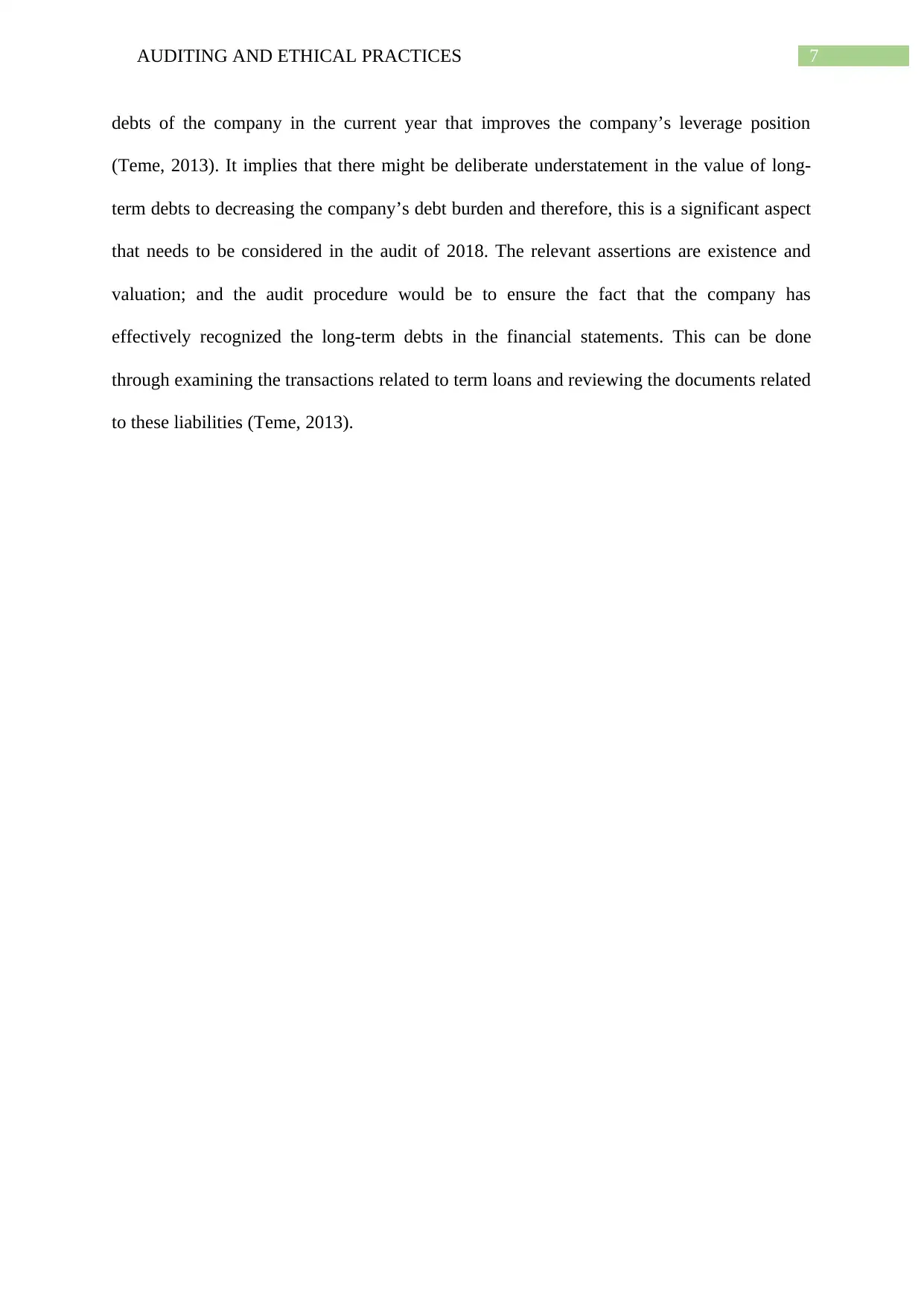
7AUDITING AND ETHICAL PRACTICES
debts of the company in the current year that improves the company’s leverage position
(Teme, 2013). It implies that there might be deliberate understatement in the value of long-
term debts to decreasing the company’s debt burden and therefore, this is a significant aspect
that needs to be considered in the audit of 2018. The relevant assertions are existence and
valuation; and the audit procedure would be to ensure the fact that the company has
effectively recognized the long-term debts in the financial statements. This can be done
through examining the transactions related to term loans and reviewing the documents related
to these liabilities (Teme, 2013).
debts of the company in the current year that improves the company’s leverage position
(Teme, 2013). It implies that there might be deliberate understatement in the value of long-
term debts to decreasing the company’s debt burden and therefore, this is a significant aspect
that needs to be considered in the audit of 2018. The relevant assertions are existence and
valuation; and the audit procedure would be to ensure the fact that the company has
effectively recognized the long-term debts in the financial statements. This can be done
through examining the transactions related to term loans and reviewing the documents related
to these liabilities (Teme, 2013).
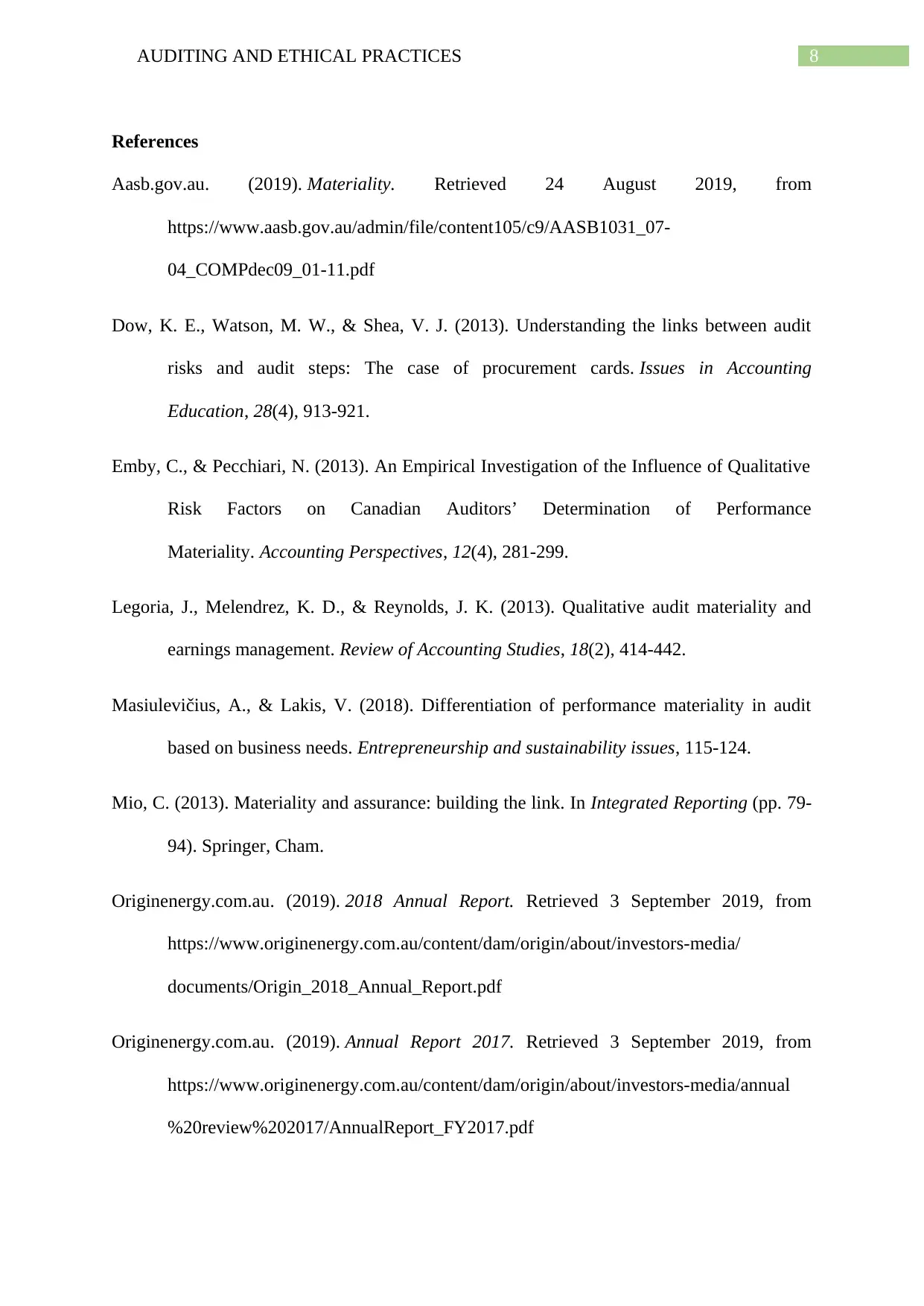
8AUDITING AND ETHICAL PRACTICES
References
Aasb.gov.au. (2019). Materiality. Retrieved 24 August 2019, from
https://www.aasb.gov.au/admin/file/content105/c9/AASB1031_07-
04_COMPdec09_01-11.pdf
Dow, K. E., Watson, M. W., & Shea, V. J. (2013). Understanding the links between audit
risks and audit steps: The case of procurement cards. Issues in Accounting
Education, 28(4), 913-921.
Emby, C., & Pecchiari, N. (2013). An Empirical Investigation of the Influence of Qualitative
Risk Factors on Canadian Auditors’ Determination of Performance
Materiality. Accounting Perspectives, 12(4), 281-299.
Legoria, J., Melendrez, K. D., & Reynolds, J. K. (2013). Qualitative audit materiality and
earnings management. Review of Accounting Studies, 18(2), 414-442.
Masiulevičius, A., & Lakis, V. (2018). Differentiation of performance materiality in audit
based on business needs. Entrepreneurship and sustainability issues, 115-124.
Mio, C. (2013). Materiality and assurance: building the link. In Integrated Reporting (pp. 79-
94). Springer, Cham.
Originenergy.com.au. (2019). 2018 Annual Report. Retrieved 3 September 2019, from
https://www.originenergy.com.au/content/dam/origin/about/investors-media/
documents/Origin_2018_Annual_Report.pdf
Originenergy.com.au. (2019). Annual Report 2017. Retrieved 3 September 2019, from
https://www.originenergy.com.au/content/dam/origin/about/investors-media/annual
%20review%202017/AnnualReport_FY2017.pdf
References
Aasb.gov.au. (2019). Materiality. Retrieved 24 August 2019, from
https://www.aasb.gov.au/admin/file/content105/c9/AASB1031_07-
04_COMPdec09_01-11.pdf
Dow, K. E., Watson, M. W., & Shea, V. J. (2013). Understanding the links between audit
risks and audit steps: The case of procurement cards. Issues in Accounting
Education, 28(4), 913-921.
Emby, C., & Pecchiari, N. (2013). An Empirical Investigation of the Influence of Qualitative
Risk Factors on Canadian Auditors’ Determination of Performance
Materiality. Accounting Perspectives, 12(4), 281-299.
Legoria, J., Melendrez, K. D., & Reynolds, J. K. (2013). Qualitative audit materiality and
earnings management. Review of Accounting Studies, 18(2), 414-442.
Masiulevičius, A., & Lakis, V. (2018). Differentiation of performance materiality in audit
based on business needs. Entrepreneurship and sustainability issues, 115-124.
Mio, C. (2013). Materiality and assurance: building the link. In Integrated Reporting (pp. 79-
94). Springer, Cham.
Originenergy.com.au. (2019). 2018 Annual Report. Retrieved 3 September 2019, from
https://www.originenergy.com.au/content/dam/origin/about/investors-media/
documents/Origin_2018_Annual_Report.pdf
Originenergy.com.au. (2019). Annual Report 2017. Retrieved 3 September 2019, from
https://www.originenergy.com.au/content/dam/origin/about/investors-media/annual
%20review%202017/AnnualReport_FY2017.pdf
⊘ This is a preview!⊘
Do you want full access?
Subscribe today to unlock all pages.

Trusted by 1+ million students worldwide
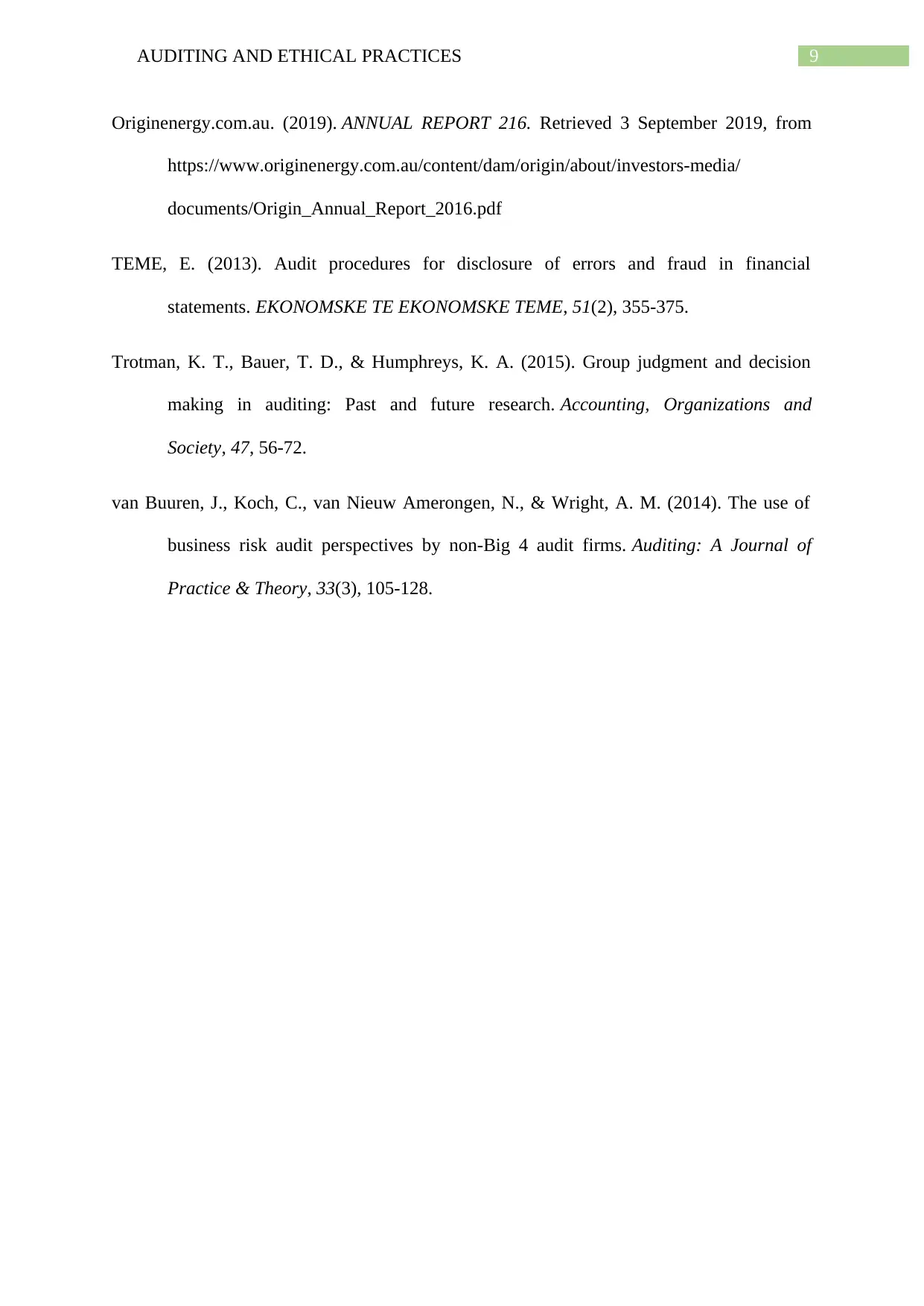
9AUDITING AND ETHICAL PRACTICES
Originenergy.com.au. (2019). ANNUAL REPORT 216. Retrieved 3 September 2019, from
https://www.originenergy.com.au/content/dam/origin/about/investors-media/
documents/Origin_Annual_Report_2016.pdf
TEME, E. (2013). Audit procedures for disclosure of errors and fraud in financial
statements. EKONOMSKE TE EKONOMSKE TEME, 51(2), 355-375.
Trotman, K. T., Bauer, T. D., & Humphreys, K. A. (2015). Group judgment and decision
making in auditing: Past and future research. Accounting, Organizations and
Society, 47, 56-72.
van Buuren, J., Koch, C., van Nieuw Amerongen, N., & Wright, A. M. (2014). The use of
business risk audit perspectives by non-Big 4 audit firms. Auditing: A Journal of
Practice & Theory, 33(3), 105-128.
Originenergy.com.au. (2019). ANNUAL REPORT 216. Retrieved 3 September 2019, from
https://www.originenergy.com.au/content/dam/origin/about/investors-media/
documents/Origin_Annual_Report_2016.pdf
TEME, E. (2013). Audit procedures for disclosure of errors and fraud in financial
statements. EKONOMSKE TE EKONOMSKE TEME, 51(2), 355-375.
Trotman, K. T., Bauer, T. D., & Humphreys, K. A. (2015). Group judgment and decision
making in auditing: Past and future research. Accounting, Organizations and
Society, 47, 56-72.
van Buuren, J., Koch, C., van Nieuw Amerongen, N., & Wright, A. M. (2014). The use of
business risk audit perspectives by non-Big 4 audit firms. Auditing: A Journal of
Practice & Theory, 33(3), 105-128.
1 out of 10
Related Documents
Your All-in-One AI-Powered Toolkit for Academic Success.
+13062052269
info@desklib.com
Available 24*7 on WhatsApp / Email
![[object Object]](/_next/static/media/star-bottom.7253800d.svg)
Unlock your academic potential
Copyright © 2020–2025 A2Z Services. All Rights Reserved. Developed and managed by ZUCOL.





